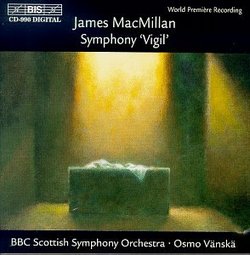MacMillan in Exultation
Thomas F. Bertonneau | Oswego, NY United States | 10/01/2000
(5 out of 5 stars)
"James MacMillan's "Vigil," a symphony in three movements for large orchestra plus brass ensemble, makes up the third "panel" of an orchestral trilogy on the Passion of Jesus Christ. Parts I and II are concerti respectively for cor anglais and cello with orchestra. The cello concerto is nearly twice as long as the cor anglais concerto; the symphony is nearly as long as the two concerti put together. I first made acquaintance with MacMillan's music through his "Veni, Emmanuel," a percussion concerto recorded by Evelyn Glennie. The Easter Triptych ("Triduum") represents MacMillan at a later, far more developed, stage of his musical maturity. "Vigil" is not only the composer's masterpiece to date; it is one of the most important additions to the orchestral repertory of the last decade. (Its date is 1997). The work opens with lower strings, woodwinds, and brass developing very basic material in the bass register. As in Parts I and II of "Triduum," one can occasionally hear how MacMillan has taken over an effect (birdsong, for example) from Messiaen, or some other composer. But his is an original voice. "Vigil" traces a line from the lowest depth to cathartic ecstasy, gradually giving greater prominence to the Gregorian Easter-song "Exultet." The central movement is a demonic scherzo. The extra brass-players, who have been stationed around the orchestra invisibly, come on-stage for the last movement to back up the orchestral brass-players. (Shades of Bruckner's Fifth.) MacMillan is a major figure in contemporary music. Yet "Vigil" (indeed the whole of "Triduum") is so powerful that it is hard to see how its composer will exceed it. (One small complaint: At forty-nine minutes, this CD gives rather short measure. My solution would have been to add on some comments by MacMillan on his music, which is what Hyperion did when they issued Robert Simpson's Ninth Symphony.)"
Darkness to Light
Christopher G. Forbes | New York, NY | 12/05/2001
(5 out of 5 stars)
"This CD represents the final work in MacMillan's Triduum. The first two pieces are the World's Ransoming, a concerto for Cor Anglaise and Orchesta, and the Cello Concerto. These two works musically describe Maundy Thursday and Good Friday respectively. With this symphony, we reach the Easter Vigil. MacMillan orders his symphony around the central liturgical symbol of the service, the progression from darkness to light. The work begins with low, repeated clusters from low strings, winds and percussion. It concludes with soft clusters from divisi violins, punctuated by the shimmer of antique cymbals. In between, MacMillan plumbs both the depth of the darkness inherant in his theme, and the joy and light which eventually triumphs. This is stunning music, stunningly performed and spectacularly engineered. One of the great works of the last decade of the twentieth century."
Excellent conclusion to the triptych
David C. Green | Suwanee, GA USA | 06/04/2008
(5 out of 5 stars)
"This piece is a very passionate piece that has great energy from beginning to end. The imagery is intense, and the orchestra on this disc really delivers the goods. After the amazing pieces for cor anglais and cello soloists on another disc, this symphony is an awesome ending to the story of the days leading to the Resurrection. The opening movement even omits violins to maintain the darkness inherent in the "triumph" of death. As the piece progresses, so does the power. It is impressive. Keep it up, MacMillan, this music is fantastic!!"

